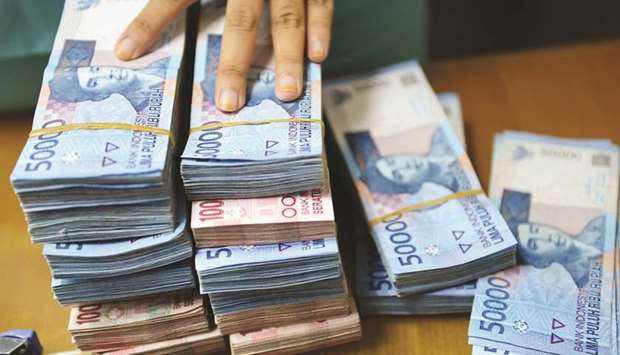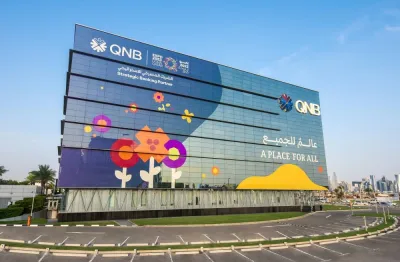The Indonesian rupiah (IDR) has “rebounded strongly” in recent months, but risks persist, QNB has said in an economic commentary.
When measured against the dollar (USD), it is up nearly 3% so far in 2019 and 8.4% since the multi-year low of October 2018. In this sense, the IDR has outperformed both the currencies of key advanced economies (DXY basket) and major emerging markets (JP Morgan Emerging Market Currency Index).
A currency appreciation is a positive development for Indonesia as the IDR faced a 5.7% depreciation against the USD in 2018, compelling Bank Indonesia (BI) to tighten policy even though the output gap was negative or the economy was not over-heated, QNB said.
Running twin current account and fiscal deficits and relying on foreign portfolio investments to close the financing gap, Indonesia is often pressured to maintain attractive risk premiums and asset prices.
Under such constraints, the IDR is particularly sensitive to global “push” factors such as higher or rising USD interest rates, broad USD strength, bouts of risk-off sentiment and lower commodity prices.
QNB analysis delves into the reasons behind the recent IDR recovery and risks for the currency over the short-term.
The IDR rally was supported by three policy responses and two positive external developments.
In terms of policy responses, first, BI has conducted a series of rate hikes last year, lifting the policy rates by 175 basis points (bps) in total and widening the gap against other key external rate benchmarks.
This is what is behind BI governor Perry Warjiyo’s ‘pre-emptive, front-loaded and ahead of the curve’ approach. Higher yields should favour domestic assets and thus prevent or limit capital outflows.
Second, the BI has undertaken supportive policy innovation with the launch of domestic non-deliverable forwards (DNDFs) settled in IDR.
The tool increases hedging options for market participants and minimises the spillover of offshore future contracts on the spot USD/IDR exchange rate, by improving the liquidity and efficiency of the onshore FX market as well as increasing overall FX supply for hedging purposes.
This, QNB said is important as periodic spikes in offshore future prices increase FX hedging costs and pressure both non-residents and residents to exit domestic assets. International experiences with DNDFs from other EM high yielders, such as Brazil, point to its effectiveness over the short-run, as spot FX demand can be temporarily deferred.
While the mechanism still has to be tested in a period of more severe market pressure on Indonesia, the market’s perceived prudential limit for BI’s peak short DNDF position is $25-35bn, which amounts to between 81-113% of the 2018 current account deficit.
Third, the government has implemented several measures to prop up external revenues and curb imports, which are expected to stop the recent widening of the current account deficit. Targeted policy measures included an expansion in the cap for coal production, a more selective approach to import-sensitive infrastructure spending, an acceleration of the plans to mix domestic biodiesel into petrol, and the imposition of tariffs on more than one thousand consumer goods.
Trade data for December 2018 is already signalling the relative effectiveness of the measures, as price-adjusted hydrocarbon imports declined significantly and imports of capital goods flattened, QNB said.
When it comes to external developments, first, markets have shifted their expectations on the outlook for US interest rates. In fact, the US Federal Reserve (Fed) has turned dovish over recent weeks, pushing down yields across the curve and favouring non-US assets.
The two year nominal yield IDR-USD differential has widened and is now 155 bps above the 2018 low.
Second, the latest bout of risk aversion has partially waned on the back of more positive developments in US-China trade negotiations and a more dovish US Fed stance.
This affects positively EM currencies in general and EM currencies of high yielders like Indonesia in particular, as more risk appetite tends to trigger a global search for yields.
“All in all, despite strong policy responses and positive external developments, Indonesia is not completely out of the woods yet.
The country is still vulnerable to short-term capital flight due to the twin deficits, a high share of long-term portfolio debt liabilities to non-residents and moderate to low FX reserve adequacy ratios.
This makes the IDR sensitive to some of the most important potential risks in 2019, including a re-escalation of trade tensions between the US and China, even weaker Chinese demand and a more hawkish US monetary policy,” QNB noted.

A currency appreciation is a positive development for Indonesia as the rupiah faced a 5.7% depreciation against the dollar in 2018, compelling Bank Indonesia to tighten policy even though the output gap was negative or the economy was not over-heated, according to QNB


